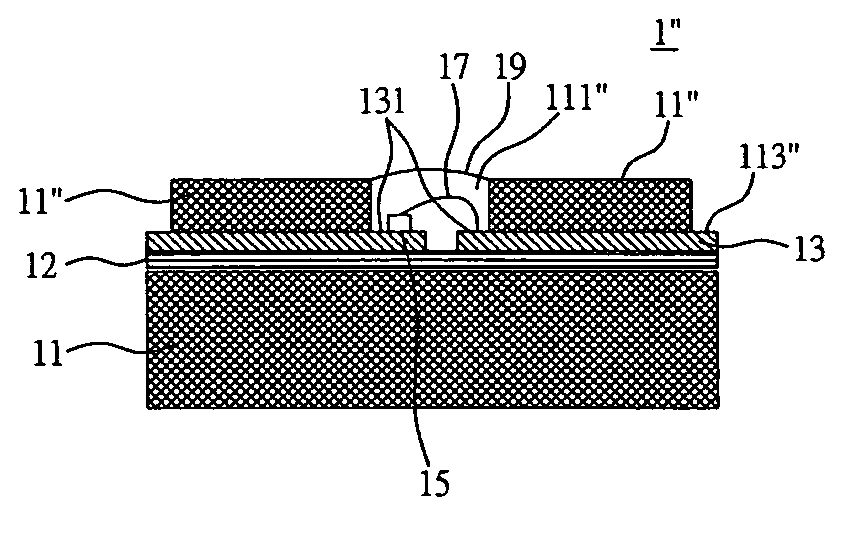High power LEDs
a technology of leds and heat dissipation leads, applied in the field of leds, can solve the problems of reducing affecting the heat dissipation efficiency of leds, and reducing so as to increase the air convection efficiency and reduce the temperature of the chip. , the effect of increasing the thermal conductivity
- Summary
- Abstract
- Description
- Claims
- Application Information
AI Technical Summary
Benefits of technology
Problems solved by technology
Method used
Image
Examples
first embodiment
[0038] FIGS. 7 to 10 are diagrams depicting a high power LED according to a first embodiment of the present invention. As shown in FIG. 7, the high power LED 1 of this embodiment includes a porous material layer 11, a thermal conductive layer 13 and a chip 15.
[0039] The porous material layer 11 can, for example, be a porous ceramic (as shown in FIGS. 8a and 8b), roughened ceramic or metal after etching or manufacturing, oxidized film with rough surface formed by anodic treatment (as shown in FIG. 9), metal foam such as aluminum foam (as shown in FIG. 10) and other equivalent elements that acts as a substrate for a package and has a large surface area contacting the air, thereby enhancing air convection for overall heat dissipation.
[0040] The thermal conductive layer 13 is disposed on the top surface of the porous material layer 11, and can be made of materials such as copper, aluminum, graphite and other equivalent materials with high thermal conductivity and electrical conductivi...
second embodiment
[0046]FIG. 11 is a diagram depicting a high power LED according to a second embodiment of the present invention, in which, elements that are similar or the same as those in the first embodiment are denoted similar or the same symbols, and descriptions thereof are omitted.
[0047] The major difference between the first embodiment and the second embodiment is in that the high power LED 1 of the first embodiment has a double-electrode design, while the LED of the second embodiment has a multiple-electrode design.
[0048] As shown in FIG. 11, the thermal conductive layer 13 is provided with a plurality of insulating portions 133, separating the thermal conductive layer 13 into many insulated regions. In this embodiment, the insulating portions 133 separates the receiving portion 131 into five electrodes 1311, 1313, 1315, 1317 and 1319 for polycrystalline use. It should be noted that although the receiving portion 131 is separated into five electrodes 1311 to 1319 by the insulating portion...
third embodiment
[0049]FIG. 12 is a diagram depicting a high power LED 1′ according to a third embodiment of the present invention, in which, elements that are similar or the same as those in the previous embodiments are denoted similar or the same symbols, and descriptions thereof are omitted.
[0050] The major difference between the third embodiment and the previous embodiments is in that the third embodiment is formed with a thermal conductive layer 13′ with high thermal conductivity and electrical conductivity stacked on top of the porous material layer (an insulating layer in this embodiment) made of a material such as copper, silver, gold, aluminum or other equivalent materials by thermal vapor deposition, sputtering, coating or other equivalent methods.
[0051] As shown in FIG. 12, the high power LED 1′ may also be manufactured with trace pattern for double or multiple electrodes (receiving portion 131 and insulating portion(s) 133 in the previous embodiments) by method such as a photolithograp...
PUM
| Property | Measurement | Unit |
|---|---|---|
| external quantum efficiency | aaaaa | aaaaa |
| thermal conductive | aaaaa | aaaaa |
| surface area | aaaaa | aaaaa |
Abstract
Description
Claims
Application Information
 Login to View More
Login to View More - R&D
- Intellectual Property
- Life Sciences
- Materials
- Tech Scout
- Unparalleled Data Quality
- Higher Quality Content
- 60% Fewer Hallucinations
Browse by: Latest US Patents, China's latest patents, Technical Efficacy Thesaurus, Application Domain, Technology Topic, Popular Technical Reports.
© 2025 PatSnap. All rights reserved.Legal|Privacy policy|Modern Slavery Act Transparency Statement|Sitemap|About US| Contact US: help@patsnap.com



